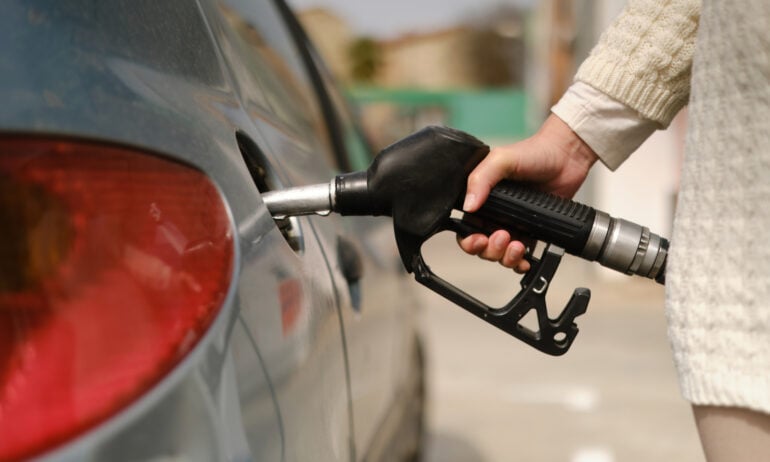Why Are Gas Prices So High?
Elevated oil prices are keeping gas prices higher than they were before the pandemic.

Many, or all, of the products featured on this page are from our advertising partners who compensate us when you take certain actions on our website or click to take an action on their website. However, this does not influence our evaluations. Our opinions are our own. Here is a list of our partners and here's how we make money.
Updated on April 17.
Gas prices are going down
The average regular gas price in the U.S. as of April 17 is $3.167 per gallon, according to AAA, down from $3.222 a week ago.
Oil prices remain at low levels not seen since 2021, and the trend is helping to bring down gas prices at an unusual time of year. Typically, prices rise as spring starts to take hold in the U.S. and stay elevated throughout the summer.
“While I do expect gas prices to continue trending lower, any abrupt change in the current tariff situation could eventually bring the decline to a halt,” Patrick De Haan, head of petroleum analysis at GasBuddy, wrote in an April 14 note.
The decline in oil prices came after President Donald Trump announced new tariffs that could upend global trade. That seems to have increased investors’ fears that the economic impact of a trade war will dampen demand for fuel and other energy products.
At the same time, the Organization for Petroleum Exporting Countries and its partners (known as OPEC+) announced their plans to ramp up production in May, which will boost global oil supplies. The decision to increase output wasn’t a surprise — it’s been anticipated for months — but it will be a bigger increase than expected.
A decline in oil prices can be good news for drivers because it typically signals a drop in gas prices. And so far, energy imports have been excluded from Trump’s tariffs. The U.S. imports about 40% of the crude oil that’s refined domestically.
Gas prices surged in 2021 and 2022 amid economic disruptions caused by the pandemic and Russia’s invasion of Ukraine — and they’ve never been the same. Today, gas prices are 15% higher than they were six years ago.
What’s keeping gas prices so high? At this time of year, seasonal factors play a considerable role in raising gas prices. A scheduled switch to summer-blend gasoline temporarily elevates prices through the warm months. Inflation, supply-chain disruptions and gas tax hikes can factor into higher prices, as well. But in the end, elevated oil prices are the main culprit.
The cost of oil typically represents more than half of the cost of a gallon of gasoline, according to data from the U.S. Energy Information Administration (EIA). So, a major reason gas prices are so high is that oil prices are still higher, on average, than they were before the pandemic and Russia’s invasion of Ukraine. That’s based on the price of West Texas Intermediate crude, which is used as the benchmark for oil prices in North America.
Keep in mind that gas prices depend on a complex set of factors and rarely reflect that day’s market conditions. Instead, they represent costs incurred weeks, even months before. That lag makes prices slower to rise and fall than news headlines might suggest. And while spot shortages, refinery production shortages or blending issues can drive up gas prices locally, big nationwide swings in gas prices are almost always due to the price of crude oil.
Yes, gas prices have gone up
The average per-gallon price of regular gas was $2.601 in 2019, according to EIA data. Then, following Russia’s invasion of Ukraine, the national average peaked at $5.016 per gallon on June 14, 2022, according to AAA. Since then, gas prices have retreated, but they haven’t returned to pre-pandemic levels.
But they’ve dropped recently. Here’s why
Gas prices began to drop steadily in the fall, and should stay relatively low through the winter. Seasonally, the direction of prices was expected. During the cooler months, consumer demand is lower and the blend of gasoline is cheaper to make. That tends to hold down prices until spring.
But price levels were the lowest we’d seen in awhile. In December, the national average nearly touched $3 per gallon for the first time since May 2021, according to AAA. (It's worth noting that, in a competing analysis, GasBuddy says the national average was $2.89 in December.) It’s currently below $3 in 21 states.
Between May 1 and Sept. 15, gas refineries switch from winter-blend to summer-blend gasoline, which is more expensive to make. That's one reason gas prices tend to increase in the spring and summer and decrease in the fall and winter. Summer-blend gasoline is formulated to limit emissions during the warmer months when gas can evaporate more easily.
Even as prices started to tick up over the past month, they’ve remained much lower than a year ago. Here’s how gas prices compare today:
The average regular gas price in the U.S. as of April 17 is $3.167 per gallon, according to AAA, which tracks gas prices.
The price is up from the average recorded a month ago at $3.078.
The price a year ago was $3.660.
At the moment, these are short-term trends happening within the larger picture of elevated gas prices. But experts said they could continue in 2025 — and the impact of Trump’s tariffs appears to make that even more likely. That’s because oil prices, though still higher than they were before the pandemic, have been trending down. WTI crude prices are down 27% since July and 50% since their peak in 2022.
Average gas price per state
The average gas price per state varies widely, with the most expensive state typically costing about $2 more per gallon of regular than the least expensive state.
» MORE: Why is diesel so expensive?

